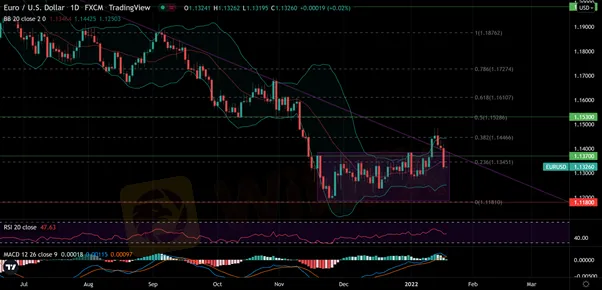简体中文
繁體中文
English
Pусский
日本語
ภาษาไทย
Tiếng Việt
Bahasa Indonesia
Español
हिन्दी
Filippiiniläinen
Français
Deutsch
Português
Türkçe
한국어
العربية
Daily Market Recap – EURUSD Rising bond yields strengthen the US dollar
摘要:The greenback appreciated against the euro, benefiting from the market's appetite for U.S. government bonds, whose yields are at their highest since the start of the pandemic.
The greenback appreciated against the euro, benefiting from the market's appetite for U.S. government bonds, whose yields are at their highest since the start of the pandemic. As investors anticipate a tightening of monetary policy in the United States, the yield on U.S. debt is rising.
The 2-year U.S. Treasury yield climbed to over 1% for the first time since February 2020, after traders increased their bets on an acceleration of the pace of rate hikes in the U.S. The Federal Reserve's monetary policy committee will meet on January 25 and 26 and investors are banking on a rate hike cycle starting in March.
In terms of economic indicators, the ZEW index for Germany posted a solid increase, with significantly fewer cases of COVID expected by the summer. Across the Atlantic, manufacturing activity in the New York area contracted sharply in January, moving into negative territory for the first time since June 2020.
After the release of U.S. inflation figures last week, the euro seemed to trigger a bullish recovery signal. As a reminder, prices were consolidating inside an ascending triangle within a bearish channel.
The breach of $1.1370 and the exit from the top of the channel suggested a bullish restart towards $1.1530. However, the euro is being hit hard by rising bond yields, so all indications are that this is a bull trap.
Indeed, the re-entry of the bearish channel with an incursion below $1.1370 reinforces this hypothesis. A close below this level is necessary to confirm the change in momentum, but nonetheless, the euro remains under pressure.

(Chart Source: Tradingview 18.01.2022)
For the time being, we favor a “bull trap” scenario, so sellers should regain the psychological upper hand. As a result, a new wave of decline could not be ruled out. The bearish flow is starting to show strength, which opens the way for a market pullback towards $1.1270 and then $1.1180.
Disclaimer: This material has been created for information purposes only. All views expressed in this document are my own and do not necessarily represent the opinions of any entity.
免責聲明:
本文觀點僅代表作者個人觀點,不構成本平台的投資建議,本平台不對文章信息準確性、完整性和及時性作出任何保證,亦不對因使用或信賴文章信息引發的任何損失承擔責任
相關閱讀

EURUSD New lows following Jerome Powell's hawkish speech
The dollar has been strengthening against the major currencies since Jerome Powell's press conference last night

Daily Market Recap – EURUSD Euro boosted after US inflation
European stock markets are moving lower on Thursday after rebounding in the last two sessions in a market context still dominated by inflation and monetary policy issues.

Daily Market Recap – EURUSD Euro could breakout following consolidation phase
The U.S. economy added a meager 199,000 jobs in the final month of 2021, well below market expectations of 400,000.

Daily Market Recap – EURUSD Euro continues its consolidation
The markets are disturbed by the advance of the Omicron variant in Europe and by a blow to the gigantic social reform plan of the American president Joe Biden.
天眼交易商
熱點資訊
頂級交易員的十項任務
等待才是交易的必修課
使用主標MT4/MT5交易軟體的CMCMarkets是否值得信任?平台真實評價完全公開
CA Markets這家交易商是否值得信賴?立即查看平台監管情形、用戶評價、網站概況
全球展業的TIS具高風險隱患?這家交易商究竟是不是詐騙?
避免外匯投資陷阱:投資人必讀指南(附實際案例)
牌照有瑕疵,資訊不透明,Morgans交易平台危機重重!
匯率計算


